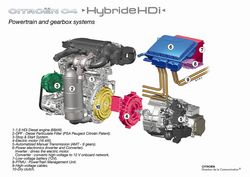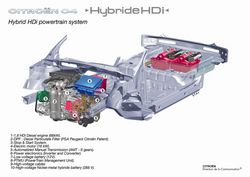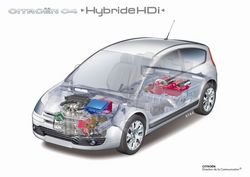.
Diesel-Electric Hybrid: Difference between revisions
mNo edit summary |
m (→Series) |
||
| Line 15: | Line 15: | ||
==Types of Diesel-Electric Hybrids== | ==Types of Diesel-Electric Hybrids== | ||
===Series=== | ===Series=== | ||
In a series type of hybrid, the diesel engine is not directly linked to the transmission for mechanical driving power. Instead, all of the energy produced from the diesel engine is converted to electric power by a generator, which recharges the energy storage device (such a battery or bank of batteries) in order to provide power to one or more electric motors. Only the electric motor system provides torque to turn the wheels of the vehicle. Because the diesel engine is not directly connected to the wheels, it can operate at a more optimum rate, and can be automatically (or sometimes manually) switched off for temporary all-electric, zero-emission operation. Series diesel-electric hybrids are well-suited for lightweight commuting vehicles and stop-and-go transit buses. | In a series type of hybrid, the diesel engine is not directly linked to the transmission for mechanical driving power. Instead, all of the energy produced from the diesel engine is converted to electric power by a generator, which recharges the energy storage device (such as a battery or bank of batteries) in order to provide power to one or more electric motors. Only the electric motor system provides torque to turn the wheels of the vehicle. Because the diesel engine is not directly connected to the wheels, it can operate at a more optimum rate, and can be automatically (or sometimes manually) switched off for temporary all-electric, zero-emission operation. Series diesel-electric hybrids are well-suited for lightweight commuting vehicles and stop-and-go transit buses. | ||
===Parallel=== | ===Parallel=== | ||
Revision as of 15:21, 12 July 2006
A diesel-electric hybrid is a vehicle that is powered by both a diesel engine and an electric motor.
Hybrid vehicles have become popular for their ability to provide zero emissions when running on electricity and improved fuel economy on the road. Diesels are also popular, especially for public transportation and for heavy-duty trucks and in passenger vehicles in Europe, for their general thriftiness and plentiful torque. Diesel-electric hybrid combine the latest advances in hybrid vehicle technology with the inherent efficiency and reduced emissions of modern clean diesel technology to produce dramatic reductions in both emissions and fuel consumption. The diesel engine's high torque, combined with hybrid technology, may offer performance in a car of over 100 mpg US (2.35L per 100 km).
Nowadays most diesel vehicles, and therefore the diesel part of hybrids, have the advantage they can (with modifications) use 100% pure biofuels (biodiesel), so they can use but do not need petroleum at all.
Production of diesel-electric hybrids so far has been limited to urban transit bus fleets. The main problem is that diesel-electric hybrid cars cost too much to produce - thousands of dollars more than gas-electric hybrids like the Toyota Prius. A diesel engine typically costs around 10 percent more than a gasoline-powered engine of similar power, even without the cost of adding an electric motor, batteries and the electronics to run them.
Diesel engines in general are not widely used for passenger cars in the United States, as US diesel fuel has long been considered very "dirty", with relatively high levels of sulfur and other contaminants in comparison to the Eurodiesel fuel in Europe, where greater restrictions have been in place for many years. Despite the "legally allowed" dirtier fuel, the US has tough restrictions on exhaust, and it has been difficult for car manufacturers to meet emissions levels. However, ultra-low sulfur diesel is set to be mandated in the United States in October 2006.
Technology
The diesel engine in a diesel-electric hybrid vehicle generates electricity for the electric motor, and in some cases can also power the vehicle directly. Unlike plug-in hybrids, diesel-electric hybrid vehicles generate all the electricity they need on-board, and never need to be recharged before use. The diesel fuel powers an internal combustion engine that is usually smaller (and therefore more efficient) than a conventional gas engine, and works in concert with an electric motor to provide the same power as a larger engine. The electric motor derives its power from an alternator or generator that is coupled with an energy storage device (such as a set of batteries or super capacitors).
Types of Diesel-Electric Hybrids
Series
In a series type of hybrid, the diesel engine is not directly linked to the transmission for mechanical driving power. Instead, all of the energy produced from the diesel engine is converted to electric power by a generator, which recharges the energy storage device (such as a battery or bank of batteries) in order to provide power to one or more electric motors. Only the electric motor system provides torque to turn the wheels of the vehicle. Because the diesel engine is not directly connected to the wheels, it can operate at a more optimum rate, and can be automatically (or sometimes manually) switched off for temporary all-electric, zero-emission operation. Series diesel-electric hybrids are well-suited for lightweight commuting vehicles and stop-and-go transit buses.
Parallel
In a parallel type of hybrid, both the diesel engine and the electric motor have direct, independent connections to the transmission. Either power source — or both of them together — can be used to turn the vehicle’s wheels. These vehicles are often designed so that the diesel engine provides power at high, constant speeds; the electric motor provides power during stops and at low speeds; and both power sources work together during acceleration. Parallel diesel-electric hybrids are well-suited to improve the fuel economy of higher performing vehicles, such as traditional sedans, or delivery vans that need to travel on the highway from city to city as well as make stops around town.
Hybrid Efficiency and Emissions Reduction Aids
Whenever a power system transfers energy from one form to another — such as a hybrid’s conversion of mechanical energy into electricity and then back again — the system will experience a decrease in energy efficiency. Diesel-electric hybrid vehicles offset those losses in a number of ways which, when combined, produce a significant net gain in efficiency and related emissions reductions. In other words, these aspects of the diesel-electric hybrid system are able to save so much energy that the vehicle as a whole overcomes the initial conversion losses. There are four primary sources of efficiency and emissions reduction found in diesel-electric hybrids:
- Smaller Engine Size - In diesel-electric hybrids, the largest gain in efficiency comes from using a smaller, more efficient combustion engine. Most traditional vehicle engines are sized to provide enough power for relatively infrequent, fast accelerations. In the more frequent cruising mode, these engines are much larger than they need to be. By adding an electric motor to deliver partial or complete power during accelerations, an diesel-electric hybrid can be equipped with a smaller, more efficient combustion engine while providing acceleration performance equal to its conventional counterpart
- Regenerative Braking - Regenerative braking is another important energy-saving mechanism used in most hybrid vehicles. Regenerative braking recovers energy normally lost as heat during braking, and stores it in the batteries for later use by the electric motor. Therefore, the engine-powered generator is used to produce electric energy only when regenerative braking does not provide a full charge.
- Power-On-Demand - Another feature that saves energy and reduces emissions in diesel-electric hybrid vehicles is the ability to temporarily shut off the diesel engine during idle or coasting modes, when the electric motor alone can provide sufficient power to keep the vehicle’s systems running without burning fuel.
- Constant Engine Speeds and Power Output - In a hybrid application, the vehicle can be designed to use its diesel engine only at the engine’s optimum power output and engine speed range. In a series hybrid, the engine is only used to power the electric generator, and not to directly provide power to the wheels at various vehicle speeds or during intermittent accelerations. In a parallel hybrid, the diesel engine can be used to power the wheels directly only at the engine’s optimum operating speeds. Allowing the diesel engine to operate more consistently at its optimum engine speed, power output, and operating temperature both increases fuel efficiency and reduces emissions. Emissions are reduced because the engine can be tuned to minimize emissions for a specific set of consistent operating conditions. This fine-tuned operation, which delivers consistent exhaust flows and temperatures, also allows after-treatment emission control technologies to be optimized.DieselForum.org - Diesel-Electric Hybrid Vehicles
Advantages and Drawbacks
Advantages
- Improved Fuel Economy: Diesel-electric hybrids achieve 25 percent better fuel economy than a comparable gasoline-electric hybrid. GM, Ford, Daimler-Chrysler and Peugeot have built concept diesel-electric hybrid concepts that have achieved from 59 mpg (4L/100km) to 80 mpg (2.9L/100km).
- ZEV Operation: In full electric mode, electric hybrid vehicles are capable of operating quietly and emission-free in inner cities and other areas prone to congestion.
- Emission Reduction: Studies have shown that diesel-electric hybrids produce significantly fewer particulate matter, nitrogen oxides, carbon monoxide and carbon dioxide emissions than the standard diesel buses. MIT's Laboratory for Energy and the Environment conducted a study comparing total lifecycle energy efficiency and greenhouse emissions (including use, production, fuel production, and eventual disposal) of internal combustion, hybrid, and fuel cell vehicles. Diesel-electric hybrids turned out to be much better than diesel, gasoline and gasoline-electric hybrid cars, and highly competitive with hydrogen fuel cell systems. MIT's Laboratory for Energy and the Environment - Comparative Assessment of Fuel Cell Cars
- Vehicle Performance: Diesel-electric hybrids achieve performance levels comparable to conventional vehicles. They have excellent power and acceleration, and a driving range that is equal to or greater than conventional or alternative fuel powered direct drive vehicles. With some diesel-electric hybrid systems such as PSA Peugeot Citreon's Hybride HDi, the electric motor is available for a power boost for extra acceleration on the highway.
- Conventional Fuel and Fueling Infrastructure: In contrast to certain alternative fuel vehicles, diesel-electric hybrids use diesel fuel and can therefore be re-fueled at conventional fueling stations. Hydrogen fuel cell vehicles, which many believe are the ultimate fuel source, will require entirely new hydrogen production, storage, and fueling facilities. Diesel-electric hybrid technology is available now, and an infrastructure is already in place.
- Cost and Availability: Diesel-electric hybrid engines are available in an increasing number of transit bus applications. This experience indicates that diesel-electric hybrids, compared to some other alternative vehicle technologies (such as gaseous fuels or fuel cell technology), may currently be more cost-effective. In comparison, highly-touted hydrogen fuel cell vehicles will require entirely new hydrogen production, storage, and fueling facilities. Diesel-electric hybrid systems can also be installed in existing automobile and truck models, which may reduce development costs.
- Biodiesel Potential: One of the compelling aspects of diesel engines is their ability to run on biodiesel, a fuel derived from biological sources. With modifications, straight vegetable oils (SVO) or waste vegetable oils (WVO)could also be used. A diesel-electric hybrid could potentially be produced that uses very little to no petroleum-derived fuel.
Drawbacks
- Price: The main obstacle preventing diesel-electric hybrid from production is cost. The price gap between a conventional diesel engine and a diesel-electric hybrid is still too wide.
- Diesel Quality: In the United States, the diesel fuel available in most locations remains the dirty, high-sulfur variety, so a diesel-electric hybrid actually may not yield a significant improvement in emissions. This will change once low-sulfur regulations take effect in 2006.
- Fleet Costs and Maintainance: For fleet vehicles such as passenger buses, initial purchase prices are high, as are maintenance costs. However, as more hybrids are produced and mechanics become more familiar with the hybrid technologies, the purchase price and maintenance costs of diesel-electric hybrids will continue to fall.
Examples of Diesel-Electric Vehicles
So far, production diesel-electric engines have mostly appeared in mass transit buses. Current manufacturers of diesel-electric hybrid buses include New Flyer Industries, Gillig, Orion Bus Industries, and North American Bus Industries. In 2008, NovaBus will add a diesel-electric hybrid option as well.
In 2003 GM introduced a diesel hybrid military (light) truck, equipped with a diesel electric and a fuel cell auxiliary power unit. Hybrid light trucks were introduced 2004 by Mercedes (Hybrid Sprinter) and Micro-Vett SPA (Daily Bimodale). International Truck and Engine Corp. and Eaton Corp. have been selected to manufacture diesel-electric hybrid trucks for a US pilot program serving the utility industry in 2004. In mid 2005 Isuzu introduced the Elf Diesel Hybrid Truck on the Japanese Market. They claim that approximately 300 vehicles, mostly route buses are using Hinos HIMR (Hybrid Inverter Controlled Motor & Retarder) system.
FedEx Express, together with Environmental Defense and Eaton Corporation, introduced the FedEx OptiFleet E700, a diesel-electric hybrid delivery truck, into its delivery fleet in 2004. The new vehicle is expected to decrease particulate emissions by 96 percent, reduce smog-causing emissions by 65 percent, and travel 57 percent farther on a gallon of fuel, reducing fuel costs by over a third.
PSA Peugeot Citroën has unveiled two demonstrator vehicles featuring a diesel-electric hybrid powertrain: the Peugeot 307 and Citroën C4 Hybride HDi. The two models feature fuel economy of 69 mpg (3.4L/100km), 25% better than a similar vehicle equipped with a gasoline-electric hybrid system. For highway driving, the electric motor can provide a 35% boost in power for better accelation when needed. (PSA Peugeot Citroën Unveils Hybrid Technology).
General Motors has been testing the Opel Astra diesel-electric hybrid. The hybrid Astra gets better than 59 mpg (4L/100 km), improving about 25% on comparable diesel models. It is equipped with a 125-horsepower turbodiesel with maintenance-free particulate filters. A production Astra using the same CDTI diesel engine found in the hybrid goes from 0-100 km/h (0-62 mph) in 12.3 seconds; the hybrid is expected to reach 100 km/h in just under 8 seconds. That kind of acceleration puts the hybrid on par with the production-model Astra's top-of-the-line 200-horsepower 2.0L ECOTEC gasoline engine. Over 360,000 production Astras, with a variety of engines and trim levels, sold in Europe last year.
At the 2006 North American International Auto Show, Ford display the sporty Reflex concept. It features a solar and diesel-electric hybrid system and delivers a maximum fuel economy of 65 mpg(3.6L/100 km).
Under development by General Dynamics Land Systems Division since 1997, the Shadow RST-V could potentially replace the U.S. military's fuel-thirsty HUMVEE. It uses less than 50 percent of the normal fuel weight of a HUMVEE, and runs on four magnet motors and two lithium-ion battery packs. But fuel efficiency wasn't the main goal - by operating on pure battery power, the Shadow's diesel-electric propulsion allows for silent movement for over 20 miles with very low thermal and acoustic signatures. [1]
In 2006, students from Philadelphia created a diesel-electric hybrid car based on a kit called the Attack, which used soybean fuel that could go from 0-60 mph in 4.0 seconds and still achieve 50 MPG. The students altered the frame to accommodate a 200-horsepower electric motor and 150-horsepower, turbocharged Volkswagen diesel engine. The little hybrid car that could
External Links
- Diesel Forum -Diesel-Electric Hybrid Vehicles
- The Dual-Drive Sprinter - Vans equipped with hybrid drive systems
- Diesel Hybrid Electric Cars Now!
- Opel Astra: GM's Hybrid Crown Jewel
- PSA Peugeot Citroen unveils diesel hybrid technology
- Ford Introduces 65 MPG Diesel-Electric Hybrid Reflex
- Bio-diesel hybrids and why you should fire your Congressperson
- Peugeot & Citroen Develop Diesel-Electric Hybrid System
- THE HUMVEE GOES HYBRID: The Diesel-Electric Shadow RST-V
- Diesel Hybrid Electric Buses
- MIT's Laboratory for Energy and the Environment - Comparative Assessment of Fuel Cell Cars
- More FedEx hybrid trucks deliver cleaner air



